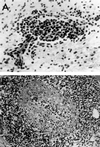Newly recognized herpesvirus causing malignant catarrhal fever in white-tailed deer (Odocoileus virginianus)
- PMID: 10747100
- PMCID: PMC86438
- DOI: 10.1128/JCM.38.4.1313-1318.2000
Newly recognized herpesvirus causing malignant catarrhal fever in white-tailed deer (Odocoileus virginianus)
Abstract
Malignant catarrhal fever (MCF) was diagnosed by clinical signs and lesions in five out of six white-tailed deer (Odocoileus virginianus) in a North American zoo. The clinical signs and histopathological lesions in these deer were typical of MCF. Antibody to an epitope conserved among the MCF viruses was detected in the sera collected from the deer. PCR failed to amplify viral sequences from DNA extracted from peripheral blood leukocytes (PBL) and/or spleens of the deer with primers specific for ovine herpesvirus 2 (OHV-2) or specific for alcelaphine herpesvirus 1 (AHV-1). By using degenerate primers targeting a conserved region of a herpesviral DNA polymerase gene, a DNA fragment was amplified from the PBL or spleens of all six deer and sequenced. Alignment of the sequences demonstrated that the virus in the deer belongs to the Gammaherpesvirinae subfamily, exhibiting 82% identity to OHV-2, 71% to AHV-1, and 60% to a newly identified bovine lymphotropic herpesvirus. This virus, which causes classical MCF in white-tailed deer, is a newly recognized agent belonging to the MCF group of gammaherpesviruses. It is the third reported pathogenic MCF virus, genetically distinct but closely related to OHV-2 and AHV-1. The reservoir for the virus has not been identified.
Figures



Similar articles
-
Detection and multigenic characterization of a herpesvirus associated with malignant catarrhal fever in white-tailed deer (Odocoileus virginianus) from Missouri.J Clin Microbiol. 2002 Apr;40(4):1311-8. doi: 10.1128/JCM.40.4.1311-1318.2002. J Clin Microbiol. 2002. PMID: 11923350 Free PMC article.
-
Active and latent ovine herpesvirus-2 (OvHV-2) infection in a herd of captive white-tailed deer (Odocoileus virginianus).J Comp Pathol. 2013 Aug-Oct;149(2-3):162-6. doi: 10.1016/j.jcpa.2013.01.005. Epub 2013 Feb 28. J Comp Pathol. 2013. PMID: 23453492
-
Goats are a potential reservoir for the herpesvirus (MCFV-WTD), causing malignant catarrhal fever in deer.J Zoo Wildl Med. 2013 Jun;44(2):484-6. doi: 10.1638/2012-0087R.1. J Zoo Wildl Med. 2013. PMID: 23805572
-
Malignant catarrhal fever: inching toward understanding.Annu Rev Anim Biosci. 2014 Feb;2:209-33. doi: 10.1146/annurev-animal-022513-114156. Epub 2013 Oct 18. Annu Rev Anim Biosci. 2014. PMID: 25384141 Review.
-
The pathology of malignant catarrhal fever, with an emphasis on ovine herpesvirus 2.Vet Pathol. 2014 Mar;51(2):437-52. doi: 10.1177/0300985813520435. Epub 2014 Feb 5. Vet Pathol. 2014. PMID: 24503439 Review.
Cited by
-
Field validation of clinical and laboratory diagnosis of wildebeest associated malignant catarrhal fever in cattle.BMC Vet Res. 2019 Feb 28;15(1):69. doi: 10.1186/s12917-019-1818-8. BMC Vet Res. 2019. PMID: 30819152 Free PMC article.
-
Possible Association of Bovine Gammaherpesvirus 6 with Pulmonary Disease in a Cow.Animals (Basel). 2023 Jan 26;13(3):417. doi: 10.3390/ani13030417. Animals (Basel). 2023. PMID: 36766305 Free PMC article.
-
Development of a multiplex real-time PCR for detection and differentiation of malignant catarrhal fever viruses in clinical samples.J Clin Microbiol. 2009 Aug;47(8):2586-9. doi: 10.1128/JCM.00997-09. Epub 2009 Jun 3. J Clin Microbiol. 2009. PMID: 19494077 Free PMC article.
-
A retrospective pathology study of two Neotropical deer species (1995-2015), Brazil: Marsh deer (Blastocerus dichotomus) and brown brocket deer (Mazama gouazoubira).PLoS One. 2018 Jun 7;13(6):e0198670. doi: 10.1371/journal.pone.0198670. eCollection 2018. PLoS One. 2018. PMID: 29879222 Free PMC article.
-
Important mammalian veterinary viral immunodiseases and their control.Vaccine. 2012 Feb 27;30(10):1767-81. doi: 10.1016/j.vaccine.2012.01.014. Epub 2012 Jan 17. Vaccine. 2012. PMID: 22261411 Free PMC article. Review.
References
-
- Avise J C. Molecular markers, natural history and evolution. New York, N.Y: Chapman & Hall Inc.; 1994.
-
- Baxter S I F, Pow I, Bridgen A, Reid H W. PCR detection of the sheep-associated agent of malignant catarrhal fever. Arch Virol. 1993;132:145–159. - PubMed
-
- Bridgen A, Reid H W. Derivation of DNA clone corresponding to the viral agent of sheep-associated malignant catarrhal fever. Res Vet Sci. 1991;50:38–44. - PubMed
-
- Crawford T B, O'Toole D, Li H. Malignant catarrhal fever. In: Howard J L, editor. Current veterinary therapy IV: food animal practice. Philadelphia, Pa: The W. B. Saunders Co.; 1998. pp. 306–309.
-
- Crawford T B, Li H, O'Toole D. Diagnosis of malignant catarrhal fever by PCR using formalin-fixed, paraffin-embedded tissues. J Vet Diagn Investig. 1999;11:111–116. - PubMed
Publication types
MeSH terms
Substances
Associated data
- Actions
LinkOut - more resources
Full Text Sources

